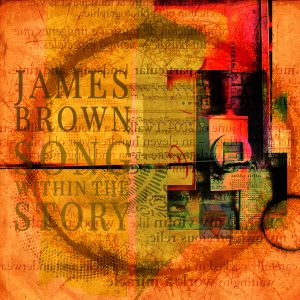Purchase here
A decade is a long time between albums, and for Canadian jazz guitarist James Brown the wait has been well worthwhile. A prolific composer with a highly cohesive working trio, he’s spent his time honing the harmonically intricate material on Song Within the Story, a consistently engaging program that documents the next step in his ongoing synthesis of jazz and European classical music. This new album, his fourth, is the work of an artist who has found some intriguing answers to longstanding musical puzzles.
Featuring bassist Clark Johnston and drummer Anthony Michelli, Brown’s trio has gained respect in recent years as one of Toronto’s top jazz combos. They’re joined on three tracks by renowned tenor saxophonist Mike Murley, whose improvisational prowess has been duly recognized over the past three decades via his contributions on 14 Juno Award-winning recordings (seven as a leader or co-leader and seven as a sideman).
“He’s such an influential player here,” Brown says of the saxophonist. “I’ve always loved his work and it was a bit of a dream of mine to use him on a recording.”
The polished interplay within the trio flows from their consummate musicianship and shared vision about the essential role of dynamic control and textural shading in bringing an arrangement to life. Brown’s clean, appealingly rounded tone and unexpectedly contoured melodic lines occupy the foreground, but in many ways the group’s sound hinges on Michelli’s exquisitely tasteful trap work.
“I like players who can play with subtlety of tone, which speaks to my classical background, and he’s very sensitive to tone production,” Brown says. “I’m so pleased with how the trio has developed. We’ve been working regularly at clubs like the Rex Jazz Bar in Toronto for three or four years, and we’ve been playing a lot of the pieces on this CD.”
The album opens with “Igor,” his captivating tribute to one of his favorite composers. Borrowing the bass figure from Soldier’s March in Stravinsky’s “L’Histoire du soldat,” the piece evolves into a sizzling minor blues before returning to the ominous theme. Dedicated to his son, “Alystair and I” is a funky syncopated shuffle in 7/4 that builds to a joyous lilt. It’s one of several tunes on the album hinting that Brown has listened closely to Bill Frisell, particularly in his more pastoral mode.
Tenor saxophonist Mike Murley makes his first appearance on the title track, a piece that Brown reimagined from the opening movement of his ambitious chamber piece “The Mosley Street Suite.” Originally a vocal setting of the T.S. Eliot poem “The Hollow Men,” the tune features some persuasively propulsive tenor work while retaining a pensive, disquieting feel. Murley is also featured on the metrically tricky but soaring theme “Sands of Swing,” a piece that brings to mind Keith Jarrett’s European Quartet.
“I’ve always like Pat Metheny and Steve Swallow and that ECM style of writing,” Brown says. “I’m not afraid of going into folk or rock. I like when there’s something a little bit more going on.”
“The Circle” is a handsome tone poem with a sing-song theme that circles back on itself without ever quite resolving. If jazz albums yielded instrumental hits, the single from Song Within the Story would definitely be “Mbira Kids,” the fourth and concluding movement from “The Mosley Street Suite.” Buoyantly polyrhythmic and innocently beautiful, the piece suggests rhythmic figures used in sacred Shona music from Zimbabwe, and Brown’s distortion-tinged solo climbs upwards, seeking transcendence.
The album’s focus is on Brown’s impressive originals, but the trio’s working repertoire is also laced with his imaginative arrangements of pop songs. The two examples he includes provide a satisfying glimpse into this transformative practice. Neil Young’s wrenching ode to the wreckage of heroin “The Needle and the Damage Done” emerges with chord changes intact almost unrecognizable as an extended dirge. The closing track, however, is a captivating rendition of Joni Mitchell’s “A Case of You,” with Johnston’s bass introducing the melody. It’s a lovely, intimate performance that whets the appetite for the trio’s next project.
Since the primary reason for the hiatus between Song Within the Story and Sevendaze, his 2009 quintet session featuring piano great Don Thompson, was the arrival of his three children, the odds are good that his next album won’t require such an extended labor. Born in 1967 in the Toronto suburb of Oakville and raised in the southern Ontario town of Burlington, Brown grew up in a fairly musical family. His maternal grandmother and paternal grandfather played traditional Québécois fiddle, and his grandmother taught piano. He started guitar lessons at age 13, and at 16 he plunged into the classical repertoire at the Royal Conservatory. Private studies with Richard Bradley and Philip Corke cemented his focus on music in high school.
“People were talking about careers and I knew I loved it so much it was what I wanted to do,” Brown recalls. “I was playing in competitions, putting on concerts and studying. I wanted to be the next Segovia or John Williams.”
Studying classical guitar at the University of Toronto, he was on the classical track through his early 20s. But with his increasing exposure to jazz, the music’s mysteries proved “too irresistible,” he says. “I had to figure it out. It was quite a shock to the system. I was heading in one direction and I couldn’t just jump into playing jazz gigs. I found some musicians in a similar situation, and started going to informal sessions.”
Some of his early inspiration came from listening to Canadian jazz guitar great Ed Bickert, a supremely sophisticated player who recorded prolifically for Concord, including sessions with Ernestine Anderson, Benny Carter, Rosemary Clooney, Dave McKenna, and Ken Peplowski. Brown caught him often at local clubs like George’s Spaghetti House and was always struck by his tone, “so very beautiful and tasteful. I thought that was the coolest thing in the world.”
While he immersed himself in jazz, Brown didn’t leave his love of classical music behind. He wrote his master’s thesis on the Third Stream Movement, the early 1960s efforts by composer and scholar Gunther Schuller and Modern Jazz Quartet pianist John Lewis to meld jazz and classical forms. His 1998 debut album, First Dance, established Brown as a gifted player and thoughtful composer with a surfeit of interesting ideas. He followed up with 2002’s The Home Fields, a chamber jazz trio session with bassist Jim Vivian and soprano saxophonist Ernie Tollar.
Brown doesn’t consider himself a Third Stream composer, but he’s definitely informed by the earlier work. Unaffected and deeply personal, his evolving compositional approach has taken on its own Brownian identity. Of course, bearing the moniker James Brown can present certain challenges, but he takes it in stride. “It’s been a great icebreaker,” he says. “I’ve heard all the jokes. People have said I should use my middle initial, but it really hasn’t been a problem.”
With Song Within the Story, Brown has taken another long step toward defining himself and his art. •
-Andrew Gilbert
The James Brown Quartet will be performing at the following venues, with additional dates to be announced: Sat. 3/26 The Jazz Room, Waterloo, ON (8:00 & 9:30 p.m.); Thurs. 4/21 Paradise Theatre, Toronto, ON (8:00 p.m.). •
James Brown: Song Within the Story
Media Contact:
Terri Hinte
510-234-8781
hudba@sbcglobal.net
Canada:
Jane Harbury
609 Soudan Avenue • Toronto, ON • M4S 1X7
landline 416.960.1568 / mobile 647.519.6706
jane@harbury.ca


